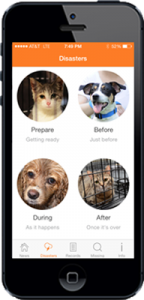We all know that February 14th is Valentine’s Day, but did you know that it is also Pet Theft Awareness Day?
Pet Theft Awareness Day is a yearly ‘holiday’ that was started by the Last Chance for Animals campaign in 1988. The National Association for Pet Sitters estimates that an average of 2 million pets are stolen each year. Dedicated to February 14th, the day brings awareness to pet theft and highlights ways to prevent theft of your beloved furbaby.
Here are a few ways to protect your pet from theft:
- Microchip your pet. It’s the number one way to make sure your pet makes it back to you.
- Organize your pet’s information. Have all of your pet’s medical information and recent pictures in a handy file.
- Ensure your yard is secure. We actually have a padlock on the gate in our backyard to prevent anyone from opening our gate. I’m sure the fluffies would love the adventure, but I disagree!
- Never leave your pet unattended. Don’t leash your pup outside a store while you run inside. So many things could go wrong.
Statistics tell us up to 2 million pets are stolen each year and that 1 in 3 pets will go missing at some point in their lives. What we may not realize is that less than 20% of dogs and 2% of cats are ever returned home.
PetHub is a company of tech geeks who love helping animals. Founder, Tom Arnold, left Microsoft to figure out a way, using the most advanced technology, to better the statistics of reuniting lost pets with their owners. They came up with a truly revolutionary pet ID tag. They’ve really upped the game, too, because over the last three years, an analysis of hundreds of dogs and cats recovered through the PetHub lost pet recovery system showed that a whopping 96.7% are home in less than a day, and 35% in just 2 hours or less! That is a great example of really making a difference!
Here’s what the PetHub ID tag does:
- the first to utilize a QR (Quick Response) code on a pet ID tag that links to a unique, easy to update online profile of your pet
- a GPS locator system for lost pets. When the QR code is scanned by a smartphone, the location of your pet is pinpointed
- a 24/7 Found Pet Hotline, the only one to offer this as a completely free service
- an NFC Chip, the same technology as the microchip will be embedded into your pet’s ID tag
- the newest is the “Signal,” a Bluetooth-enabled tag that connects to a free smartphone app, and features a remote LED light and range finder (between 150-500 feet, depending on the model of smartphone). This combines with their existing QR code, web profile & 24/7 call center.
- their Pet Protect360 (www.petprotect360.com ), where you can get a DNA “genetic paw print” that can be used as a pet theft deterrent
Follow these 5 important tips to protect your pet from theft:
- At home, keep your pets supervised at all times. Think twice before letting your cat roam freely around the neighborhood or tying your pup to the tree in your front yard.
- Running an errand? Leave your pet at home. Although walking your dog while tackling your daily chores may seem like you’re accomplishing double-duty, the reality is that it only takes a few seconds for a dog-napper to take off with your pet.
- Follow the same rules for pets of all breeds and sizes. Although purebreds and small dogs are the most desirable to a thief for obvious reasons, big friendly dogs or mixed breeds can be just as easily lured into a get-away car waiting nearby.
- Spay or neuter your pet. February is National Spay and Neuter Awareness Month and the ARL has been sharing the many health and behavioral benefits of the low-risk procedure. Another perk? Spayed or neutered pets are much less desirable to thieves, since they can’t be bred.
- Microchip your pet. It only takes a second for a thief to remove your pet’s collar, making them very difficult to identify should they turn up at an animal shelter or hospital. Quick and painless, microchipping your pet is extremely important to ensure that you and your pet are reunited.
If you find yourself in a situation where you think your pet was stolen:
- Immediately file a report with your local police department and animal control.
· Contact your pet’s microchip company, as well as local animal shelters and hospitals to see if your pet has turned up.
· Post fliers around your neighborhood, especially in public spaces and businesses, with your pet’s photo, name, breed, color, weight and any distinguishing characteristics.
· If you offer a reward, ask for a very detailed description of your pet and how they came into that person’s possession. If you suspect that you are being scammed, call the police.
· Monitor newspaper ads and online postings to look for any that might fit your pet’s description.
PREVENT PET THEFT BEFORE IT HAPPENS! Report any suspicious activity, or animal cruelty and neglect to your local police department and animal control office.
Pet Theft Do’s and Don’ts
- DO educate family, friends and neighbors about pet theft, especially each year on Feb. 14th – Valentine’s Day – Pet Theft Awareness Day.
· DO keep your dog indoors, especially when you’re not home. Outdoor dogs should be kept safely behind a locked gate.
· DO walk your dog on a leash.
· DO keep cats strictly indoors. Indoor cats live safer, longer, healthier lives.
· DO provide your pets with collars, I.D. tags, and licenses. Speak with your veterinarian about tattooing and microchipping.
· DO report suspicious neighborhood activities and/or missing companion animals to the police and animal control.
· DO keep recent photos of companion animals.
· DO spay and neuter your companion animals. Fixed animals are less likely to stray. - DON’T leave companion animals unattended in your yard. It only takes a few seconds for thieves to take them.
· DON’T tie your dog up outside of restaurants, coffee shops or stores, and never leave any animal unattended in a car.
· DON’T allow your dog to be visible from the street.
· DON’T use “free to good home” ads to place your companion animal. If you can no longer care for your pet, contact the local humane society or animal rescue for help.

And don’t forget The ASPCA mobile app is a must-have app for pet owners.
Get the ASPCA Mobile App here.
This free app shows pet parents exactly what to do in case of a natural disaster. It also allows pet owners to store vital medical records, and provides information on making life-saving decisions during natural disasters.
With a few swipes, you can:
- Access critical advice on what to do with your pet before, during, and after a major storm—even if there’s no data connectivity.
- Store and manage your pet’s critical health records.
- Receive a personalized missing pet recovery kit, including step-by-step instructions on how to search for a lost animal in a variety of circumstances.
- Build a lost pet digital flyer that can be shared instantly on your social media channels.
- Get the latest and most relevant news about pets and animal welfare.








